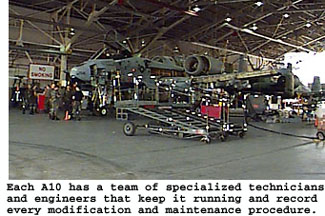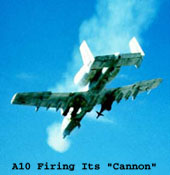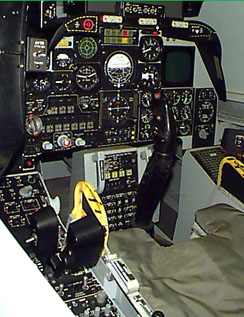 Popularized in the Gulf War and the prior NATO action in Bosnia, the A-10s and pilots of the 103rd Fighter Wing (pictured here) were used to relieve the Air Force's regular A-10 pilots during the all important Christmas and holiday seasons. This was especially important during the enforcement of a "no fly zone" over Bosnia. The crew change was seamless and provided a welcome break for the weary pilots and families who had been separated by the Eastern European conflict. The present conflict, should it continue, will likely result in similar relief efforts. The importance of Air National Guard pilots was underscored by an interesting story that was related by Master Sergeant Joel Dobbin, the 103rd's Visual Information Manager concerning the capabilities of the squad's pilots.
"One of our pilots, Lt. Col. Dan Peabody, is a law school graduate from UCONN who started a small, quiet practice in Maine. Maintaining his status as a "week-end warrior," Dan was one of the A-10 pilots that volunteered to relieve pilots in he UN's "Decisive Endeavor" operation in Bosnia. Never having been subjected to actual battle conditions, Dan found himself on a routine flight, basically to "show the flag" when he received an emergency call for help from a ground based unit of the UN's French Foreign Legion that was pinned down by enemy fire. Being the closest asset, Dan and his wing man immediately went to assist the UN troops under fire. For some reason, Dan's own gun jammed, leaving him vulnerable to ground-to-air attack. Despite this vulnerability, Dan flew as a decoy, purposely attracting the flack of enemy guns while his wing man was able to accomplish the mission, destroy the enemy targets and free the UN forces
Each reserve pilot in the 103rd Wing, stationed in Windsor Locks, Connecticut, must accomplish 72 training mission flights every year. These flights usually involve sorties to a special base in upstate New York where targets and bull's eye markers are used to simulate actual strategic targets. Each mission of this type is extensively planned, emergency contingencies are formulated and, after the training mission, video and tactical information are reviewed with an emphasis on safety and performance. There is a built-in system that is continuously striving for perfection and competition is encouraged.
Aside from the mechanical safety defense systems in the A-10, most pilots feel the greatest comfort in the secure knowledge that, in the event of their plane being shot down, the military has an equally committed group of rescue teams who will stop at no end to save the downed pilot. Pilot safety, unlike that in some other countries, is paramount in the US military.
An average A-10 pilot has spent one year as an undergraduate pilot, 6 months at fighter school and 2 months just learning about the A-10. After this, he is given about a year to become "mission qualified" - at which time he or she is considered battle ready.
To viewed the cockpit of an A-10 with its multiplicity of controls, switches and gauges is impressive. Every pilot must pass a "blind fold" test where they are asked to locate and activate various controls purely by sense of touch. This skill could be the difference between life and death during combat, when the pilot's attention is keenly focused.
The A-10 must face ground missile threats as well as attacks by other aircraft. Pods on each wing dispense foil chaff to confuse radar. Heat flares also can be ejected to distract heat-seeking missiles. If a dogfight ensues, a dark black patch painted on the undercarriage has been added to simulate the cockpit so, at a distance, an opposing plane will be confused as to the orientation and direction of the A-10.
Flying the Warthog requires almost super-human skill. A-10s actually refuel in flight by lining up with a long hose that is extended from a flying gas station - usually a huge Stratotanker. This too must be mastered as it is one of the A-10s routine events. Most flying formations are very tight. I'm told that in thick clouds the pilots usually will maintain a wing-to-wing tip distance of only a few feet! There is no room for error in these cockpits.
There are only 144 A-10's in the world. 77 are in regular service with the Air Force while 77 are now in the control of the Air National Guard. With the changing threats of terrorism and non-nuclear conflicts likely in the future, the dependence on this unique plane and support teams in the Air National Guard will undoubtedly take a more active role in America's global police actions and the suppression of aggressive countries along side the Air Force's regulars. In fact, the awesome responsibility for protecting the geographic US airspace and borders is now entirely assumed by the Air National Guard units located all over the US.
Viewzone thanks the men and women if the 103rd Air Wing for sharing the details of this defender of freedom.
|

 From the pilots perspective, the A-10 is a slow aircraft. Fully loaded with shells and bombs, the plane can reach speeds of only 450 miles per hour and cannot accelerate rapidly. This vulnerability, however, is well compensated by enclosing the pilot inside what is called the "bathtub" - a titanium reinforced shell that will protect the pilot from a direct hit from most flack. The fuel inside the A-10 is enclosed in special foam chambers to prevent fumes from forming and thus reduces the potential for fuel fires from hits to the fuel tanks. In addition, the wing tips have honey-comb pods that can eject either aluminum foil "chaff" or heat flares - designed to confuse and divert and radar or heat seeking missiles that have locked on to the aircraft during its flight over enemy terrain. The plane is also equipped with sensing "ears" that listen for approaching missiles, a heads-up control display and night vision capabilities.
From the pilots perspective, the A-10 is a slow aircraft. Fully loaded with shells and bombs, the plane can reach speeds of only 450 miles per hour and cannot accelerate rapidly. This vulnerability, however, is well compensated by enclosing the pilot inside what is called the "bathtub" - a titanium reinforced shell that will protect the pilot from a direct hit from most flack. The fuel inside the A-10 is enclosed in special foam chambers to prevent fumes from forming and thus reduces the potential for fuel fires from hits to the fuel tanks. In addition, the wing tips have honey-comb pods that can eject either aluminum foil "chaff" or heat flares - designed to confuse and divert and radar or heat seeking missiles that have locked on to the aircraft during its flight over enemy terrain. The plane is also equipped with sensing "ears" that listen for approaching missiles, a heads-up control display and night vision capabilities. To accomplish this task, our government will usually invest from one to two million dollars on training and sharpening the skills of each pilot. While the A-10 comes at a moderate price tag of a few million dollars for each basic plane, the countless hours of service and maintenance quickly add up. Excellence is not without its price.
To accomplish this task, our government will usually invest from one to two million dollars on training and sharpening the skills of each pilot. While the A-10 comes at a moderate price tag of a few million dollars for each basic plane, the countless hours of service and maintenance quickly add up. Excellence is not without its price.